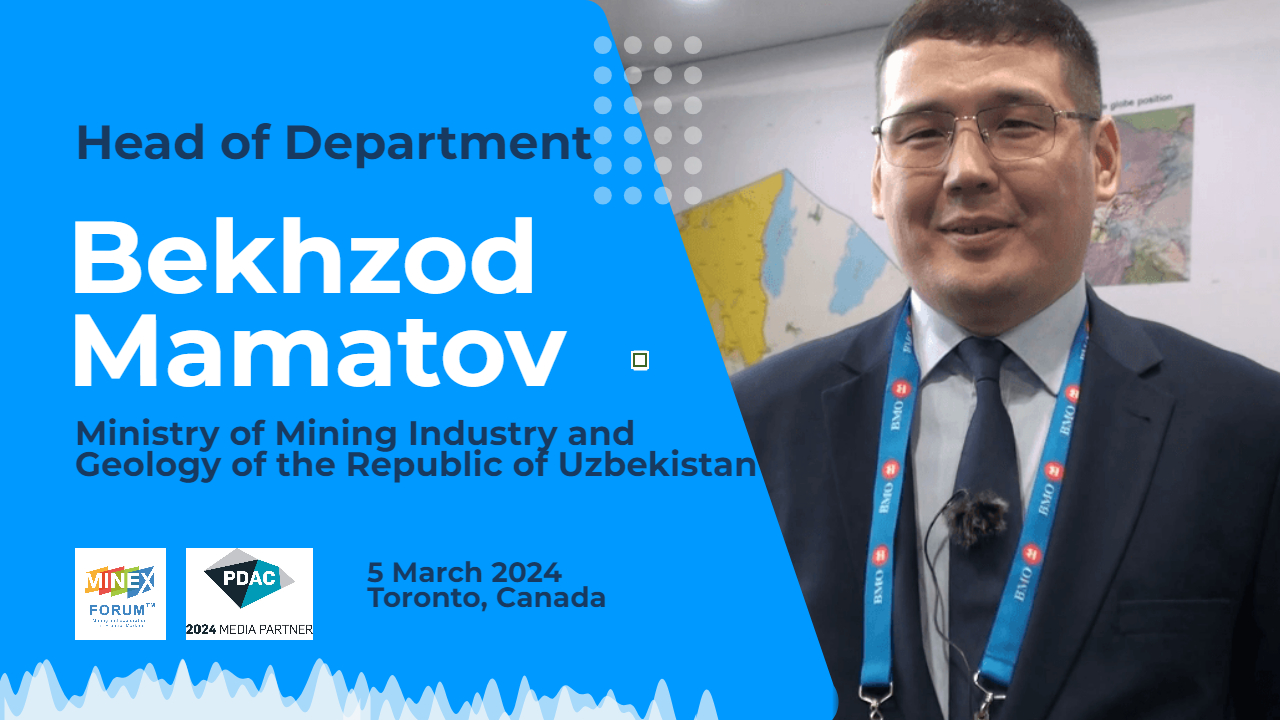4 March 2024 – Toronto, Canada
The Republic of Uzbekistan’s official delegation made its debut at the PDAC (The World’s Premier Mineral Exploration and Mining Convention in Toronto, Canada, marking a significant step towards international engagement. With over 30,000 participants and 1,000+ exhibitors from 100+ countries annually attending the event since its establishment in 1932, the Convention serves as a global platform for industry collaboration. MINEX Forum, a key information partner in Europe and Central Asia, traditionally participates in PDAC.
MINEX Forum conducted interviews with leaders and representatives of the Uzbek delegation at PDAC 2024. One such interview was with Bekhzod Mamatov Head of Department of the Ministry of Mining and Geology of the Republic of Uzbekistan, shedding light on Uzbekistan’s objectives and initiatives at the convention.
MINEX Forum (MF): What objectives brought the Ministry to PDAC, and what are you hoping to achieve?
Bekhzod Mamatov (BM): Greetings! Our participation at PDAC is crucial for our nation’s economic strategy, which emphasises openness and international collaboration. We aim to showcase our market’s openness and our plans to the global community.
MF: What is Uzbekistan presenting at its pavilion? Could you elaborate?
BM: This marks our debut at PDAC, signalling our initial steps towards presenting our country’s geological potential to global investors. We’re here to highlight Uzbekistan’s geology, available territories, permit acquisition processes, tax benefits, and much more.
MF: Given PDAC’s historical association with junior companies involved in exploration projects, who is your target audience here? Are you aiming to attract junior companies for exploration or larger corporations for significant mining projects?
BM: We welcome all, from junior companies to major corporations. Understanding the global mining market dynamics, we believe it’s beneficial for juniors with international experience to enter our market, potentially bringing in larger investors. We’re currently developing a legislative framework to attract junior companies, which, in turn, should help in attracting major investors. This includes a new approach to exploration, primarily funded by investors with minimal state involvement.
MF: Are there any specific investment projects and new mechanisms for engaging with investors?
BM: We’re in the preparatory phase, drafting a subsoil use law that outlines the process for obtaining exploration permits and the novel concept of rights alienation. Currently, over ten foreign investors are involved in Uzbekistan’s mining sector.
MF: Can you discuss the new economic program announced by President Shavkat Mirziyoyev and the mining industry’s role within it?
BM: Our development strategy up to 2030 sets clear goals for the mining sector: to increase gold production by 1.5 times, copper by 3.5 times, silver by 3 times, and uranium by 3.5 times. These targets are expected to be met through both domestic funding and international investment.
MF: Regarding the modernisation of mining enterprises and the creation of production clusters, what is the strategic vision for the industry? Is there a focus on developing natural resources and production increase, or on establishing processing facilities?
BM: Currently, we process annually over 100 million tons of gold ore and 40 million tons of copper ore. The mining sector’s total investment projects exceed 23 billion US dollars. With these investments, we aim to boost copper ore processing capacity to 200 million tons per year, increasing the demand for engineering products and chemicals in the sector.
In 2021, a Presidential Decree initiated the creation of a copper cluster, encompassing engineering product localisation and copper production and processing projects. Last year, copper processing reached 57 thousand tons, and we anticipate surpassing 100 thousand tons this year.
Moreover, we’re keen on attracting foreign investment in geological exploration. Investors obtaining exploration permits gain exclusive rights to develop any discovered deposits. This strategy not only aims to enhance gold and copper production but also to explore critical metals, supporting the development of electrical product manufacturing in Uzbekistan.
We’re looking to attract investors for critical metal deposits from neighbouring countries and beyond, including Canada, the United States, and European nations.
Interview video recording

